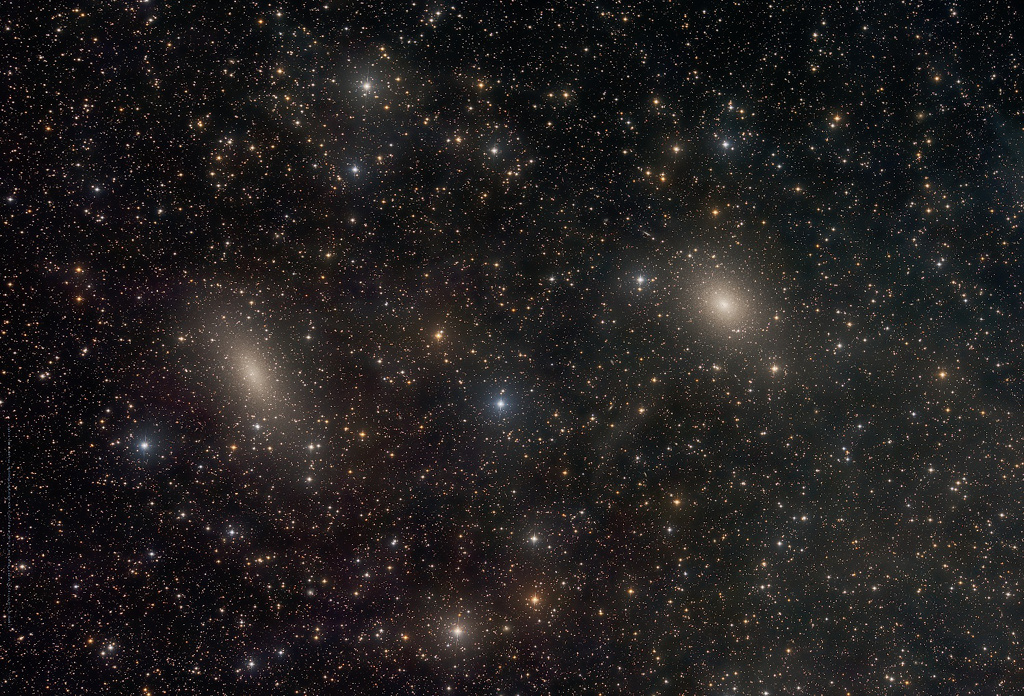orin stepanek wrote: ↑Thu Nov 04, 2021 1:32 pm
I thought NGC147 & NGC185 looked like star clusters; glad I read the
contents! On the above photo they do look like Galaxies; but on the
blowups seemed like clusters!

Orin, yes, that's fascinating, isn't it? So what's the difference between a globular cluster and a galaxy?
Don't know if I'll be able to tell you, but let's have a crack at it anyway...
Note in the picture of NGC 185 that this spheroidal galaxy has at least one globular cluster. (Actually it has more; see
here.) So in other words, galaxies can have globular clusters, but globular clusters can't have galaxies.
Also, galaxies are built up over billions of years. Yes indeed, a few galaxies stop forming stars very early, but most galaxides certainly keep it up for billions of years. That means their stars are of different ages, and the stars have different metallicities, because the gas that they were born from contained different levels of elements more massive than hydrogen and helium. (That, of course, is because the interstellar and intergalactic medium is constantly being enriched with heavier elements as stars die and "spit out" the heavier elements that they have forged inside them as they ran through more and more
cycles of fusion in their battle against gravity.)
Globular clusters, by contrast, are formed (the way I understand it) in a single event, so that all the stars in them are the same age. The stars inside them are also very old, and many of them are 10-12 billion years old. Possibly not a single galaxy will form in a single event, never forming any new stars after that initial burst. Admittedly I can't be sure of this. However, NGC 185 certainly kept on forming stars for a long time:
Wikipedia wrote:
Martínez-Delgado, Aparicio, & Gallart (1999) looked into the star formation history of NGC 185 and found that the majority of star formation in NGC 185 happened at early times. In the last ~1 Gyr, stars have formed only near the center of this galaxy.
So NGC 185 has formed stars during the last one billion years. No globular cluster will do that. Clearly the stars that were recently born in NGC 185 were born from the cloud of gas and dust that is visible in the center of this dwarf spheroidal. No globular cluster will have an obviously visible dust cloud in its center.
All globular cluster have metal-poor stars, that is, their stars were formed from gas clouds that contained only very low levels of any other elements than hydrogen and helium. Galaxies like NGC 185 and NGC 147 are also likely to be metal-poor, but certainly not as metal-poor as a globular cluster.
According to a blurb I found summarizing a scientific paper, NGC 6388 is a very metal-rich globular cluster. And NGC 185 and NGC 147 are two metal-poor spheroidal galaxies. Nevertheless, NGC 147 and NGC 185 should still be more metal-rich than globular cluster NGC 6388. Let's take a look at two not exactly comparable
color-magnitude diagrams of the stars in globular cluster NGC 6388 and dwarf spheroidal galaxy NGC 185:
There are differences in stellar content between the globular clusters and the dwarf spheroidal galaxies. The globulars have longer horizontal branches (which extend horizontally to the left and then curve down) than the galaxies. The galaxies, by contrast, have shorter horizontal branches, broader, thicker main sequences (at bottom) and thicker, broader blue straggler branches (which extend from the main sequence branch to the upper left towards the horizontal branch).
In short: The stellar contents are different in globular clusters and dwarf spheroidals, and almost any expert would (I think) be able to tell the difference between a globular cluster and a dwarf spheroidal simply by looking at their color-magnitude diagrams.
Ann
 NGC 147 and NGC 185
NGC 147 and NGC 185







